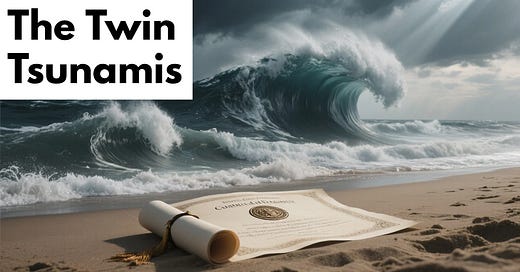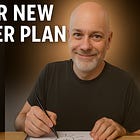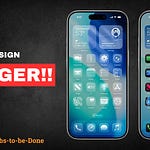Introduction: The Twin Tsunamis Facing Higher Education
For generations, the university has been a bedrock institution, selling a simple, powerful promise: a degree is your ticket to a stable, prosperous career. But today, that bedrock is being eroded by two colossal, converging tsunamis.
The first tsunami is economic and immediate. You see it all around you. The crushing weight of over $1.7 trillion in student debt. The frustrating reality of graduates being underemployed, their expensive credentials disconnected from the practical skills employers need right now. This wave is forcing a reckoning, causing employers—the ones who actually need the talent—to bypass the old system and build their own, more efficient talent pipelines.
But there is a second, far larger tsunami gathering force just behind it, one that threatens to reshape the entire landscape of work itself. This is the wave of Artificial Intelligence. We are on the cusp of an era where AI will not just augment, but automate many of the white-collar, knowledge-work tasks that have been the entire destination for college graduates. The "safe" careers in law, accounting, marketing, and even software development are in the crosshairs.
Focusing only on the first wave—solving the employer's immediate problem—is a critical error. It's like redesigning a better sail for a ship, just as the age of steam is dawning. The true, urgent challenge is not merely to fix the broken pipeline to yesterday's jobs. It is to completely reimagine the purpose of education in a world where the very concept of a stable, lifelong "job" is becoming a historical artifact. Who is the customer of education when the ultimate consumer is no longer a corporation hiring for a role, but an individual who must create value in a world saturated with artificial intelligence?
The Core Job of Education: A Dated Diagnosis for a Bygone Era
The Traditional Narrative: A Degree as a Ticket to a Stable Career
The 20th-century university model was built on a foundation of stability. It was designed to produce reliable inputs for a relatively predictable corporate machine. You, the student, hired the university to confer a credential, a signal of your intelligence and diligence. In return for this signal, an employer would grant you a job, often with a clear path for advancement. The system worked because the pace of change was slow enough for a four-year degree to remain relevant for a significant portion of a career.
This led to the great bundling: general education, majors, campus life, sports—all packaged together as the "college experience." You bought the whole package because it was the only socially accepted and institutionally validated path to the professional world.
A Jobs-to-be-Done Diagnosis: Uncovering the Real, Evolving Goals
The Jobs-to-be-Done framework demands we look past this bundled solution and identify the real progress people are trying to make. For decades, the student's job was clear: Acquire the capabilities needed to secure a good job. The employer's job was equally clear: Acquire talent to drive business value.
The traditional university did an increasingly poor and inefficient job of serving both. But the rise of AI forces us to elevate the student's Job-to-be-Done to a much higher, more abstract level. The job is no longer to secure a job. It is to develop the enduring capacity to create economic value and personal fulfillment in a constantly changing world. This is a profound and terrifying shift, and it renders the old model almost completely obsolete.
The Great Unbundling: First Ripples in a Coming Storm
The current disruptions we see in education are the first signs of the system breaking down under the pressure of the first tsunami—the economic one. They are important because they show us the direction of change, but we must see them as transitional steps, not the final destination.
Working Today: The Employer as a Transitional Customer
Because universities are failing to deliver job-ready talent, employers are stepping in to solve their own problem. This is a logical, but intermediate, step.
The Rise of the Corporate University: A Short-Term Fix
When companies like Google, IBM, or major consulting firms create their own academies to hire kids straight from high school, they are engaging in a brilliant tactical move. They get perfectly trained, culturally-aligned talent with no student debt and high loyalty. It solves their immediate JTBD with ruthless efficiency. However, even these forward-thinking companies are primarily training for the jobs of today. While they can adapt their curricula far faster than a traditional university, they are still aiming at a target—the corporate role—that AI is actively transforming.
Micro-credentialing and Outcome-Aligned Models: A Bridge to What's Next
Similarly, the explosion of skills-based certificates and Income Share Agreement (ISA) bootcamps are a direct response to the university's failure. They unbundle the degree, allowing you to acquire a specific, marketable skill quickly and efficiently. They are a better bridge from learning to earning. But they are still a bridge to the existing world of work. What happens when the other side of that bridge—the job itself—is swept away?
Beyond Employability: Preparing for a World Transformed by AI
This is the central question. If AI can write code, draft legal documents, analyze financial statements, and create marketing campaigns, what is left for humans to do? The answer is: everything that AI can't do. The future of human value creation lies in areas that require deep creativity, complex problem-framing, critical and ethical thinking, and genuine human connection.
This means the "customer" of education is no longer a single entity. It's a multifaceted ecosystem of new roles and ways of being.
[Image: A diagram showing the old linear path (University -> Student -> Employer) being replaced by a new hub-and-spoke model. The central hub is "Individual Capability" which connects to multiple endpoints: "Corporate Projects," "Entrepreneurial Ventures," "Creative Audiences," and "AI Collaboration."]
Who is the Customer When the "Job" Disappears?
The Sovereign Individual: The Rise of the Entrepreneurial Self
In a world where the cost of executing complex tasks plummets due to AI, the opportunity for individuals to act as "businesses of one" explodes. A single person, armed with powerful AI tools, can now do what used to require a whole team. The new "job" is entrepreneurship. The educational system must therefore serve this new customer: the sovereign individual.
The New JTBD: Identify novel problems and opportunities, and assemble the necessary human and AI resources to create and capture value independently.
What they need to learn: Not a specific vocational skill, but a meta-skill set: how to identify unmet needs (the core of JTBD itself), how to design a business model, how to lead a hybrid team of people and AI agents, how to sell, and how to build a personal brand.
The Human-in-the-Loop Specialist: The AI Whisperer and Auditor
AI is not an autonomous oracle; it's a tool that requires skillful operators. A new class of professional will emerge whose value lies at the interface between human intent and machine execution. Think of an "AI-assisted doctor" whose skill is not just in diagnosis, but in knowing which questions to ask the diagnostic AI to uncover hidden patterns. Or an "AI-auditor" for a law firm, whose job is to ensure the legal bots are operating ethically and without bias.
The New JTBD: Master the collaboration between human ingenuity and artificial intelligence to achieve outcomes that neither could accomplish alone.
What they need to learn: Deep domain expertise in their chosen field (law, medicine, science) plus a deep literacy in how AI models work, their limitations, and the art of "prompting" and interacting with them to push the boundaries of their performance.
The Creator: The Monetization of Uniquely Human Perspective
As AI handles the production of generic content, the value of unique, authentic, human perspective will soar. The creator economy is not a fad; it's the beginning of a massive economic shift where individuals can monetize their specific knowledge, their personality, and their ability to build a community around a shared interest.
The New JTBD: Develop a unique point of view and cultivate the skills to build and monetize a direct relationship with an audience.
What they need to learn: Storytelling, audience-building, video production, writing, community management, and the ethics of influence. These are the new liberal arts for the digital age.
Novel Concepts for a New Reality: Education for Resilience, Not Roles
To serve these new customers, we need to move beyond today's unbundling and imagine entirely new systems for learning and value creation. The goal is to build solutions that are not just better than the university, but are designed for this new, AI-infused world.
The "Value Creation-as-a-Service" (VCaaS) Ecosystem
This is the evolution of the "Talent-as-a-Service" model. Instead of providing companies with "talent," this platform would help organizations solve problems by assembling bespoke teams of humans and specialized AIs. An organization wouldn't "hire a marketer"; it would present the platform with a business challenge ("increase lead generation from this demographic by 20%") and the VCaaS platform would deploy a "flash team" to solve it. This team might include a human strategist, a creative director, and a suite of AI agents to handle the copywriting, media buying, and data analysis. The human is valued for their strategic and creative oversight, not their ability to perform the routine tasks.
The AI-Powered Personal Resilience Architect
This is the necessary evolution of the "Personalized Learning Architect." Its primary goal is not to help you find a job. Its primary goal is to make you antifragile in a rapidly changing world.
This AI companion would be constantly scanning the economic and technological landscape. Its dashboard wouldn't just show you courses to take; it would show you which of your current skills are most at risk of automation and which uniquely human skills are increasing in value. It would then architect a personalized journey to help you fortify your position. This journey would be a blend of activities:
Project-based work sourced from the VCaaS ecosystem to gain practical experience.
Connections with mentors who excel in creative, human-centric fields.
Simulations that challenge your ethical reasoning and complex problem-solving abilities.
Workshops on mindfulness, communication, and leadership—the soft skills that are becoming the hard skills of the new economy.
This AI architect is your lifelong partner in navigating uncertainty. Its singular focus is on keeping you on the right side of the automation curve.
Conclusion: Your Only Moat is to Be More Human, More Creative, and More Adaptable
We stand at a pivotal moment. The twin tsunamis of economic pressure and artificial intelligence are not a threat to be weathered, but a force that is clearing the way for something new. The credential-based economy is ending, and a new capability-based economy is being born. But even that is a transition. The ultimate destination is a creativity-based economy, where value is generated by the things only humans can do.
Your response to this shift will define your future:
For Executives: Your challenge is not just to find talent; it's to redesign work itself. How can you restructure your organization into a fluid, project-based entity that leverages hybrid teams of humans and AI? Stop hiring for pedigree and start creating opportunities for people to develop the uniquely human skills that will drive your business forward.
For Entrepreneurs: The greatest opportunities in history are emerging at the intersection of human talent and artificial intelligence. Build the tools for the sovereign individual. Create the platforms for the Human-in-the-Loop Specialist. Develop the communities for the Creator. Solve the JTBD of personal resilience in an age of uncertainty.
For Individuals—Every Student, Parent, and Professional: The advice to "get a good job" is dangerously outdated. The new imperative is to become irreplaceable. Your only long-term moat is to cultivate your most human skills. Double down on creativity, critical thinking, empathy, and leadership. Learn to use AI not as a replacement, but as a bicycle for the mind—a tool to amplify your innate human ingenuity. Stop asking "What job do I want?" and start asking "What value can I, as a unique human, create in the world?"
The old institutions will not save you. The only person who can architect your future in this new world is you.
In a world where AI can do most knowledge-based tasks, what is the single most important human skill you believe we should be teaching every child?
Creativity Trigger Reference
The novel concepts presented were developed by applying specific creativity triggers to the core job of "developing the capacity to create economic value."
Follow me on 𝕏: https://x.com/mikeboysen
If you'd like to see how I apply a higher level of abstraction to the front-end of innovation, please reach out. My availability is limited.
Mike Boysen - www.pjtbd.com
Why fail fast when you can succeed the first time?
📆 Book an appointment: https://pjtbd.com/book-mike
Join our community: https://pjtbd.com/join















Share this post